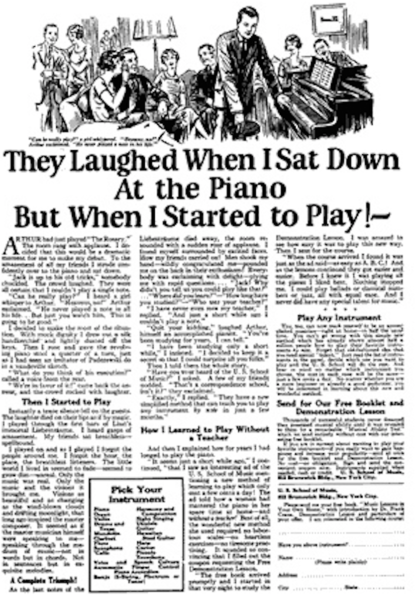
In 1926, a long-form print ad for the U.S. School of Music was written by John Caples, and the headline read, “They Laughed When I Sat Down At the Piano, But When I Started to Play!” It’s been noted as one of the most perfect headlines ever written. This formula has been used time and time again, and is one of the reasons sites like BuzzFeed rose to internet fame by adopting the same headline style, which had been out of practice for some time, especially online, but not in subscription marketing.

We talk occasionally about how we crib from direct mail sales letters in subscription marketing, and if you look at the greatest long-form sales letters, they came from the 40’s, 50’s and 60’s, the pinnacle of copywriting. And these sales letters form the foundational work upon what other copywriters are still building today—even if they don’t know it.
[text_ad]
I know it… you’re thinking, how is it possible that the state of copywriting rose to the best sixty to seventy years ago? Two reasons:
A. Human beings haven’t changed very much in how we are motivated to take action.
B. In those days, they were reliant on direct mail, so they had to be really good at it. Millions of dollars were spent on long or direct sales letters that were in this gladiatorial arena. It was a Six Sigma split-testing environment where five copywriters or agencies would go head to head, and four would lose.
This should still be the case. We’d love to say that the most cutting edge visual formatting on a subscription marketing page, designed by a hip millennial, pulls better than a well-written long-form sales letter. But most times it doesn’t. It just goes to show you how human beings haven’t changed in terms of fundamental psychology, and why would we?
Our Chief Copywriter, Bill Dugan, is inspired by this golden age of copywriting, and it informed some of his most successful direct marketing copy, such as:
- “10 Foods You Should Never Eat” for Nutrition Action
- “What Never to Say to Your Staff” for Manager’s Edge
- “Save an Hour a Day: How to Accomplish More in Less Time” for The Organized Executive
All three of these headlines are very successful, long-running controls.
“Even in today’s online world, words matter…sometimes even more than ever!” says Dugan, a life long direct response copywriter and expert in subscription marketing. “Copywriting is not a lost art, but a reinvigorated one for those who want to make sales, generate leads, inspire people to act, and have lasting influence. Consumers and business professionals alike respond to well-crafted copy, and it’s high time that online marketers get back to the basics about direct-response copy.”
If you’re looking for great examples of copywriters to learn from, some classics include:
- John Caples
- Bill Jayme
- Gene Schwartz
- Bob Bly
- Mark Johnson
- Don Hauptman
- Herschell Gordon Lewis
- David Ogilvy
Our overall philosophy on subscription marketing copy is to be constantly testing offers and creative. As they say, “different strokes for different folks.” If you’re not yet testing your magazine offers and creative copy, we suggest you start and seek to continuously improve your response rates. Our experience shows that over any given 12 month period, response rates will decline by about 40% for a publisher who keeps the same offer up year after year.
To learn more about writing great subscription marketing copy, read:
- How to Write Copy for a Subscription Website That Sells
- 3 Ways to Say “Free” in Subscription Marketing
- Six Sigma Subscription Marketing: 12 Offers That Boost Response Rates
Discover how to improve your sales copy by letting us take the reins. If you’re a legacy magazine publisher, schedule a call with us and learn how we can partner with you to build a highly profitable web magazine library. You supply the content, we supply the marketing and technology, and we jointly share the rewards.
What’s a fun fact about subscription marketing copy you can add? Share in the comments below.



